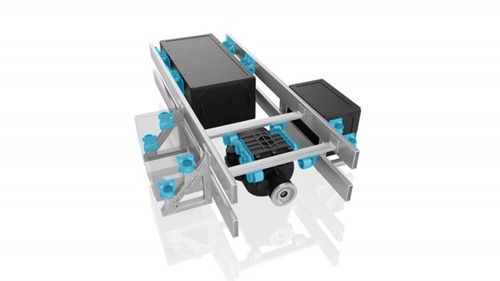Move in anticipation of a shift in commercial vehicles segment, similar to passenger car transformation
Weinheim, Germany – Vibracoustic has sharpened its focus on new noise, vibration, and harshness (NVH) technologies to equip commercial vehicles (CVs) with low- and zero-emissions powertrains.
In particular, Vibracoustic announced in December that it had created NVH-optimised mounting systems for battery packs, electric motors and fuel cells used in heavy vehicles.
The developments come in anticipation of a ‘transition' towards electrified CVs, as observed in the passenger car market, said the Weinheim-based supplier.
“A heightened focus on alternative powertrains aims to provide more sustainable transportation of goods and people,” explained Vibracoustic.
The trend, it said, brings many “unique and complex NVH challenges”, from the distinct acoustics of electric motors and inverters to the weight and safety considerations around battery packs.
While the use-case differs substantially from passenger cars, Vibracoustic is leveraging its experience in automotive NVH management to develop “best-suited solutions” for CVs.
With lower weight and higher torque than internal combustion engine (ICE) counterparts, electric motors produce a wide range of frequencies, including 'excitations' of over 600Hz.
These, according to Vibracoustic, can be disturbing for the human ear, particularly when coupled with other noises which are left unmasked by the quieter powertrain.
 As a result, Vibracoustic said its engineers developed e-motor mounting systems that meet isolation and decoupling requirements of CV OEMs.
As a result, Vibracoustic said its engineers developed e-motor mounting systems that meet isolation and decoupling requirements of CV OEMs.
One solution, specifically developed to promote comfort while addressing the high frequency excitations in electric CVs is called 'double-isolation'.
This uses two layers of rubber components: one between the e-motor and subframe, the other between the subframe and chassis.
The subframe thereby acts a blocking mass whose inertia – with the correctly designed vibration technology system – can drastically reduce transmission of higher-frequency vibrations or structure-borne noise.
Double-isolation is particularly relevant for CV applications, such as e-buses where a high number of passengers are exposed to those excitations.
Another development involves battery packs, which can weigh from 100kg to 6,000kg, posing “significant challenges linked to weight, mounting, crash loading and NVH”.
Here, Vibracoustic has designed "comprehensive mounting solutions" that can minimise the transfer of road-vibrations to the battery pack.
Furthermore, it stated, the designs can enhance structural integrity and overall frame stiffness, especially if the battery is an integrated element of the chassis.
The battery mounts also play an important safety role as they help reduce forces in an impact, acting as a robust energy absorber and dissipator, Vibracoustic noted.
The CV sector has begun to electrify and decarbonise, bringing about new challenges, said Peter Binner, head of business unit commercial vehicles at Vibracoustic.
Our solutions for electric motors, battery packs, and fuel cells will help "customers to deliver greener and quieter vehicles for a more efficient commercial transportation future,” Binner added.



